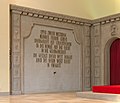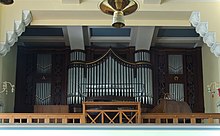Church of the Resurrection (Hamburg-Barmbek)
The Church of the Resurrection in Hamburg-Barmbek-Nord , also called “Church on Tieloh” after its location, is the church of the Evangelical Lutheran parish. The community belongs to the Hamburg-Ost parish of the Evangelical Lutheran Church in Northern Germany .
history
For many centuries the population of Barmbek was looked after by churches in the neighborhood. During the Thirty Years' War the Barmbeker were parish in St. Jacobi . In 1629 it was reorganized to St. Georg . After 1885 the St. Gertrud Church in Hamburg-Uhlenhorst became the parish church for Barmbek. The first church in Barmbek was not built until 1900 with the Catholic St. Sophien . In 1903 the Holy Spirit Church was consecrated in the center of the former village.
The Barmbek church council considered it necessary to build another church in North Barmbek, where around 20,000 people lived at that time, and wanted a group building consisting of a church and a parish hall with various meeting rooms. The declared aim was to promote community formation with lectures outside of worship and youth care. The property on the corner of Tieloh and Hellbrookstrasse was made available in June 1913 and four architects were commissioned to draw up plans. After the unanimous decision of the jury made up of Wilhelm Emil Meerwein, among others , the design by the then 33-year-old Camillo Günther won . His plan, which was based on the Wiesbaden program, envisaged the church at the intersection of Tieloh and Hellbrookstrasse and placed the parish hall with its steep gable further north on the Tieloh. Both buildings were to be connected by two pastorates a little way back, so that a connected church ensemble was to arise.
The first installment of 100,000 marks required for the start of construction was requested in August 1913 and again in January 1914, but not approved, although there were 108,056 parishioners in Barmbek in 1914, for whom only the small Heiligengeistkirche was still available. The use of various advocates and a collection of signatures by means of leaflets were ultimately convincing. In September 1915 the synod approved the sum of 205,000 marks . A final obstacle was the architect, who had become compulsory due to the war that had begun. However, the Senate Military Commission had Camillo Günther deferred for some time. The foundation stone was laid on January 23, 1916 and the church was consecrated on May 16, 1920 . The parish hall could only be inaugurated much later, on December 2nd, 1927. The church survived the extensive destruction of Barmbek in the Second World War without damage. However, the parish hall, only a few meters away, was severely damaged.
Building description
The Resurrection Church is a clinker-clad concrete building, which is designed as a round church with an attached altar niche. The dome consists of an inner flat dome and a high outer dome on concrete ribs, which supports the dome shell and the baroque style lantern with the bells, which is visible from the outside. There are 400 seats in the nave and a further 230 seats on the gallery .
The ceramic external architectural decoration by Richard Kuöhl includes the slogan held by angels above the main portal, the heads of Melanchthon and Luther above the entrance front, the ceramic cross on the main facade, the clock and the frames of the portals as well as the half-reliefs on the parapet, which scenes represent from the Bible.
The ensemble, consisting of a church, community hall, intermediate wing, pastorate and garden courtyard, was entered in the Hamburg list of historical monuments in 2000 .
Furnishing
Pulpit and baptismal font
The natural stone pulpit is a foundation of the former church council Heinrich Dreckmann. On the front side is an eagle and the inscription Those who wait in the Lord gain new strength that they rise with wings like eagles. pictured. Both are covered by the current parament cloth and are therefore not visible. The baptismal font made of artificial stone is located directly in front of the pulpit . Two sides are each decorated with a praying angel figure and on the upper edge there is a circumferential inscription. Don't you know which spirit children you are? The baptismal font has a crowned lid made of metal to protect it from contamination.
Sanctuary
The altar is made of artificial stone. The altarpiece was executed as a mosaic and comes from Axel Bünz . It shows the way to Golgata with the three crosses and the Easter sun in the background, based on the seal of the Church of the Resurrection . The light buildings on the edge represent the temples and towers of Jerusalem. Under the altarpiece is a carved from linden wood representation of the Lord's Supper by Richard Kuöhl , flanked by the proverbs Let yourselves be reconciled with God and the love of Christ urges us .
To the right of the altar is the access to the sacristy , which is closed by a curtain , on the opposite side there is an inscription:
Victims of two world wars - men, women, children - carried away on battlefields - on the run at home - in captivity - the shape of this world is passing - But the word of the Lord remains - for ever.
In the past there was a memorial on this side of the chancel depicting a dying warrior . Corresponding to today's inscription in the chancel, a second inscription was unveiled on the south wall of the church at the suggestion of Ralph Giordano on the occasion of a visit to the church in 2008, which expands the circle of people to be remembered.
organ
The organ was made in 1924 by the Walcker organ builder and is one of the largest and most valuable organs in the region. The first major renovation was carried out in 1954 by the Kemper company . By the company GF Steinmeyer & Co. , the organ was rebuilt in 1965 and again electrified in this course. The organ has around 2,600 pipes in 38 sounding registers . The visible, so-called prospect pipes, are only built as decorative pipes and are not placed on a wind tunnel.
Bells
In the church tower there are two bells made of sound steel, cast by the Bochumer Verein . The basic tones are D and F, so that the triad D - F - A flat arises when the bell rings.
literature
- Heidi Grunwaldt, Reinhold Bill: 75 years of the Resurrection Church and parish of North Barmbek. Michael Weidmann, Hamburg 1995.
Web links
Individual evidence
- ↑ Website of the Church of the Resurrection, accessed on August 15, 2017
- ↑ History ( Memento of the original from March 5, 2013 in the Internet Archive ) Info: The archive link was inserted automatically and has not yet been checked. Please check the original and archive link according to the instructions and then remove this notice. on Auferstehungskirche-barmbek.de.Retrieved on October 6, 2012
- ↑ Bettina Vaupel: Luther's lip. The Church of the Resurrection in Hamburg-Barmbek . In: Monumente , vol. 26 (2016), issue 3, p. 31.
- ^ A. Krause: Thirty Years of the Parish of North Barmbek 1920–1950
- ↑ Description of the organ ( Memento of the original from November 18, 2011 in the Internet Archive ) Info: The archive link was inserted automatically and has not yet been checked. Please check the original and archive link according to the instructions and then remove this notice. on Auferstehungskirche-barmbek.de.Retrieved on October 6, 2012
Coordinates: 53 ° 35 ′ 31 ″ N , 10 ° 3 ′ 7 ″ E












